The Dollar and Deflation
Elliott waves in FX might be anticipating deflation.
Demand for U.S. dollars has surged over the past couple of weeks as the economic and financial sanctions on Russia cause all sorts of ramifications. Essentially, taking out an active chunk of the day-to-day global capital markets reduces financial transactions and makes the availability of U.S. dollars a little scarcer. For example, according to estimates by Credit Suisse, Russia holds about $300 billion in short-term money market instruments, $200 billion in FX swaps and another $100 billion through public and private deposits. Freezing this means that it cannot be used to grease the wheels of the money markets as it usually would. The cost of funding transactions in U.S. dollars has risen.
However, demand for U.S. dollars also rises when sentiment is becoming more cautious and negative. Most of the planet’s debt is denominated in, or linked to, U.S. dollars. When people get nervous, they want to ensure that they have dollars to either service that debt or pay it back. In the coming debt deflation, expect demand for U.S. dollars to go through the roof.
Ah, but then there’s the Fed.
Since the Great Financial Crisis of 2008, whenever demand for U.S. dollars has surged, the Federal Reserve has utilized so-called “swap lines” with other central banks around the world in order to ensure that there is an ample supply of U.S. dollars to meet everyone’s needs. This has tended to coincide with a period of U.S. dollar strength in the foreign exchange (FX) market, which then subsequently turned into weakness.
The current Elliott wave structure in the chart of EUR-USD suggests that the current period of U.S. dollar strength could be close to ending. Could this coincide with the Fed re-opening and perhaps extending its swap lines in order to ease the demand for U.S. dollar funding? Perhaps.
If so, we can anticipate that sentiment will become more negative in the short-term to trigger the Fed to act. Dollar weakness will not come about because the Fed extended swap lines. Rather, the socionomic way to think about it is that dollar strength (often associated with a deflation lurch) will cause the Fed to act.

